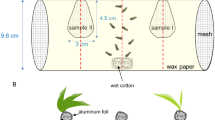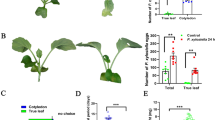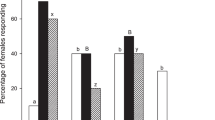Abstract
A mixture of four volatile compounds, (Z)-3-hexenyl acetate, α-pinene, sabinene and n-heptanal, emitted from cabbage plants infested by diamondback moth [DBM; Plutella xylostella (L.)] larvae attracts Cotesia vestalis (Haliday), a major parasitoid of DBM larvae. The volatiles may affect other organisms, such as DBM conspecifics, other herbivores and carnivores. Here, we studied whether the volatiles affect the oviposition behavior of DBM females. In a climate-controlled room, five pots of komatsuna plants (Brassica rapa var. perviridis L. cv. Rakuten; leaf vegetable) were placed in an acrylic box. For the treatment, we placed a bottle-type dispenser of the volatiles (0.01% in a triethyl citrate solution) next to the center pot. For the control experiment, we used a container with plants and triethyl citrate only. The presence of the volatiles did not affect the number of eggs per plant. Interestingly, DBM females laid more eggs on the adaxial leaf surfaces in the treatment compared with the control. This is the first study showing that plant volatiles affect the oviposition site preference of herbivores on leaves. The results are discussed in relation to the application of attractants for DBM control in commercial greenhouses.

Similar content being viewed by others
References
Abe J, Urano S, Nagasaka K, Takabayashi J (2007) Release ratio of Cotesia vestalis to diamondback moth larvae (Plutella xylostella) that suppresses the population growth of diamondback moth feeding Brassica leaf vegetables in a greenhouse. Bull NARC West Reg 6:125–132 (in Japanese with English summary)
Arimura G, Matsui K, Takabayashi J (2009) Chemical and molecular ecology of herbivore-induced plant volatiles: proximate factors and their ultimate functions. Plant Cell Physiol 50:911–923. doi:10.1093/pcp/pcp030
Badenes-Perez FR, Reichelt M, Gershenzon J, Heckel DG (2011) Phylloplane location of glucosinolates in Barbarea spp. (Brassicaceae) and misleading assessment of host suitability by a specialist herbivore. New Phytol 198:549–556. doi:10.1111/j.1469-8137.2010.03486.x
Bolter CJ, Dicke M, Van Loon JJA, Visser JH, Posthumus MA (1997) Attraction of colorado potato beetle to herbivore-damaged plants during herbivory and after its termination. J Chem Ecol 23:1003–1023. doi:10.1023/B:JOEC.0000006385.70652.5e
Carroll MJ, Schmelz EA, Meagher RL, Teal PEA (2006) Attraction of Spodoptera frugiperda larvae to volatiles from herbivore-damaged maize seedlings. J Chem Ecol 32:1911–1924. doi:10.1007/s10886-006-9117-9
De Moraes CM, Mescher C, Tumlinson JH (2001) Caterpillar-induced nocturnal plant volatiles repel conspecific females. Nature 410:577–580. doi:10.1038/35069058
Dicke M (1986) Volatile spider-mite pheromone and host-plant kairomone, involved in spaced-out gregariousness in the spider mite Tetranychus urticae. Physiol Entomol 11:251–262. doi:10.1111/j.1365-3032.1986.tb00412.x
Dicke M, Sabelis MW, Takabayashi J, Bruin J, Posthumus MA (1990) Plant strategies of manipulating predator-prey interactions through allelochemicals—prospects for application in pest control. J Chem Ecol 16:3091–3118. doi:10.1007/BF00979614
Horiuchi J, Arimura G, Ozawa R, Shimoda T, Takabayashi J, Nishioka T (2003) Comparison in response of Tetranychus urticae (Acari: Tetranychidae) and Phytoseiulus persimilis (Acari: Phytoseiidae) to volatiles emitted from lima bean leaves with different level of damages made by T. urticae or Spodoptera exigua (Lepidoptera: Noctuidae). Appl Entomol Zool 38:109–116. doi:10.1303/aez.2003.109
Kobori Y, Amano H (2003) Effect of rainfall on a population of the diamondback moth, Plutella xylostella (Lepidoptera: Plutellidae). Appl Entomol Zool 38:249–253. doi:10.1303/aez.2003.249
Menzel TR, Huang T-Y, Weldegergis BT, Gols R, van Loon JJA, Dicke M (2014) Effect of sequential Induction by Mamestra brassicae L. and Tetranychus urticae Koch on lima bean plant indirect defense. J Chem Ecol 40:977–985. doi:10.1007/s10886-014-0499-9
Oluwafemi S, Bruce TJA, Pickett JA, Ton J, Birkett MA (2011) Behavioral responses of the leafhopper, Cicadulina storeyi China, a major vector of maize streak virus, to volatile cues from intact and leafhopper-damaged maize. J Chem Ecol 37:40–48. doi:10.1007/s10886-010-9891-2
Philips CR, Fu Z, Kuhar TP, Shelton AM, Cordero RJ (2014) Natural history, ecology, and management of diamondback moth (Lepidoptera: Plutellidae), with emphasis on the United States. J Integr Pest Manage 5:D1–D11. doi:10.1603/IPM14012
Shimoda T, Mitsunaga T, Uefune M, Abe J, Kugimiya S, Nagasaka K, Sano K, Urano S, Suzuki Y, Yano E, Takabayashi J (2014) A food-supply device for maintaining Cotesia vestalis, a larval parasitoid of the diamondback moth Plutella xylostella, in greenhouses. Biocontrol 59:681–688. doi:10.1007/s10526-014-9611-x
Shiojiri K, Takabayashi J (2003) Effects of specialist parasitoids on oviposition preference of phytophagous insects: encounter-dilution effects in a tritrophic interaction. Ecol Entomol 28:573–578. doi:10.1046/j.1365-2311.2003.00539.x
Shiojiri K, Takabayashi J, Yano S, Takafuji A (2000) Flight response of parasitoid toward plant-herbivore complexes: a comparative study of two parasitoid-herbivore systems on cabbage plants. Appl Entomol Zool 35:87–92. doi:10.1303/aez.2000.87
Shiojiri K, Ozawa R, Kugimiya S, Uefune M, van Wijk M, Sabelis MW, Takabayashi J (2010) Herbivore-specific, density-dependent induction of plant volatiles: honest or “cry wolf” signals? PLoS One 5:e12161. doi:10.1371/journal.pone.0012161
Sugimoto K, Matsui K, Iijima Y, Akakabe Y, Muramoto S, Ozawa R, Uefune M, Sasaki R, Alamgir KM, Akitake S, Nobuke T, Galis I, Aoki K, Shibata D, Takabayashi J (2014) Intake and transformation to a glycoside of (Z)-3-hexenol from infested neighbors reveals a mode of plant odor reception and defense. Proc Natur Acad Sci USA 111:7144–7149. doi:10.1073/pnas.1320660111
Takabayashi J (2014) Infochemical webs and tritrophic interactions. eLS. doi:10.1002/9780470015902.a0021912
Talekar NS, Shelton AM (1993) Biology, ecology, and management of the diamondback moth. Annu Rev Entomol 38:275–301. doi:10.1146/annurev.en.38.010193.001423
Uefune M, Choh Y, Abe J, Shiojiri K, Sano K, Takabayashi J (2012) Application of synthetic herbivore-induced plant volatiles causes increased parasitism of herbivores in the field. J Appl Entomol 136:561–567. doi:10.1111/j.1439-0418.2011.01687.x
Urano S, Uefune M, Abe J, Takabayashi J (2011) Analytical model to predict the number of parasitoids that should be released to control diamondback moth larvae in greenhouses. J Plant Interact 6:151–154. doi:10.1080/17429145.2011.555007
Zakir A, Sadek MM, Bengtsson M, Hansson BS, Witzgall P, Anderson P (2013) Herbivore-induced plant volatiles provide associational resistance against an ovipositing herbivore. J Ecol 101:410–417. doi:10.1111/1365-2745.12041
Acknowledgements
This research was partly supported by the Bio-oriented Technology Research Advancement Institution, by JST “Science and Engineering Entrepreneurship Development Program for Vigorous Researchers (SEED-V)” and by Grants-in-Aid for Scientific Research from MEXT (Grant numbers 15K07230 and 26292030).
Author information
Authors and Affiliations
Corresponding author
Additional information
Handling Editor: Miriama Malcicka.
Masayoshi Uefune and Kaori Shiojiri have contributed equally to this work.
Rights and permissions
About this article
Cite this article
Uefune, M., Shiojiri, K. & Takabayashi, J. Oviposition of diamondback moth Plutella xylostella females is affected by herbivore-induced plant volatiles that attract the larval parasitoid Cotesia vestalis . Arthropod-Plant Interactions 11, 235–239 (2017). https://doi.org/10.1007/s11829-016-9484-2
Received:
Accepted:
Published:
Issue Date:
DOI: https://doi.org/10.1007/s11829-016-9484-2




